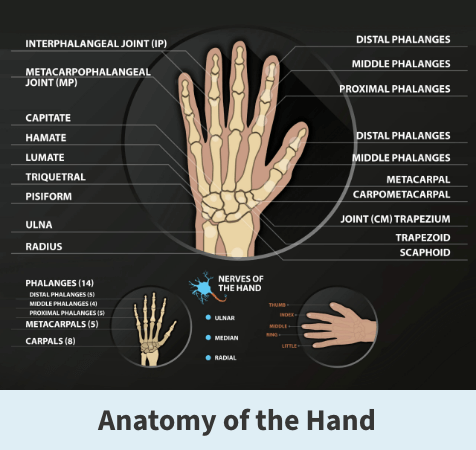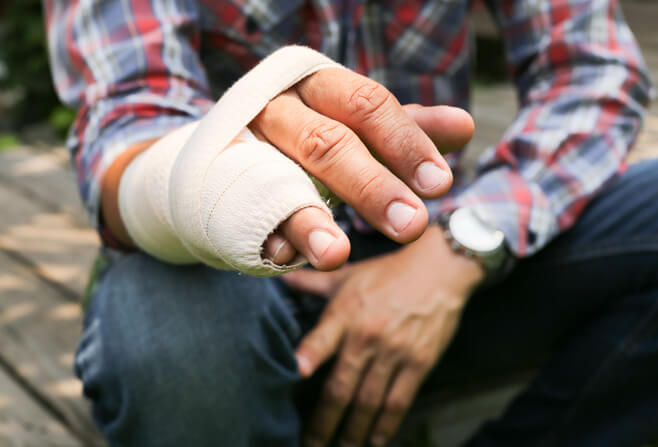Anatomy

The hands are made up of finger bones, muscles, and a host of soft tissues, including joints, ligaments, and tendons. Also, your hands have blood carrying channels known as veins and arteries.
A partially or completely severed hand is a significant trauma. But with quick action and prompt evaluation followed by a treatment known as hand replantation, you might not only be able to have the severed feature reattached but regain a significant amount of strength and mobility.
About
Replantation is often performed to reposition severed hands or components like fingers or other separated tissues or structures.
In most cases, replantation is used following a traumatic injury, such as an automobile accident. Hands and fingers are often severed as the result of sharp, slashing actions or crushing.
Treatment
The goal of reattachment is to not only replace the severed body part but attempt to restore all lost movement. Unfortunately not everyone will be a suitable candidate. Your Florida Orthopaedic Institute surgeon will determine your eligibility for replantation based upon your injury’s severity. Certain detached parts are simply too damaged to be attached.
That said, not all hope is lost. If your doctor determines you are not a good candidate for replantation, there are other treatment options, such as prostheses insertion or revision amputation. A prosthesis is an artificially created finger or hand. During revision amputation, a surgeon might remove lingering tissue from the accident site to prevent potentially serious consequences like infections.
The replantation process
Replantation is a delicate, multi-step procedure. Before your hand or finger or other tissue is reinserted, you go through several phases.
- Phase one – Any remaining damaged tissue at the trauma site is carefully and thoroughly removed.
- Phase two – The bone ends of the severed site must be joined together. Typically, this process is performed using objects, such as screws, wires, pins, or plates.The purpose of this undertaking is to provide a stable base, which will enable the reinserted hand or finger to fit into place.
- Phase three – During this final stage of replantation, a surgeon repairs whatever damage exists in the severed feature. For example, injuries to muscles, soft tissues, or blood vessels will be fixed.
The recovery process
Following replantation surgery, expect to undergo an extensive recovery process. The specific time you need to regain movement and strength varies depending upon several factors, including:
- Joint involvement – Injuries that do not involve damage to joints stand a better chance of regaining mobility.
- Age – Typically, younger persons experience quicker and more efficient nerve regrowth, which is crucial to regaining movement and strength.
- Trauma type – Many surgeons suggest that cleanly severed hands or fingers are more likely to regain a significant degree of movement than crushed or mangled body parts.
- Climate – Colder climates tend to slow the recovery process.
Patients who smoke can speed up their recovery by stopping smoking. This habit interrupts circulation and limits blood flow to the replanted region.
Once surgical wounds have sufficiently healed, you will need to undergo a course of physical therapy. In coordination with your surgeon, these are exercises designed by a medical professional known as a physical therapist. Physical therapy improves your hand’s mobility and strength.
Orthopedic and vascular surgeons stress that you should not expect to regain full mobility in the replanted hand, digit, or tissues. Recovery is gradual, and most medical professionals maintain that ultimately recapturing anywhere from 60 to 80 percent mobility is considered a good result.
Potential complications
Specific issues of concern that might need additional surgical intervention include scar tissue removal, the release of stiff or locked joints, or the repair of damaged or scarred nerves.
When additional surgery is needed
Some patients who have undergone replantation surgery may need additional surgery to regain full use of their hand or finger. Some of the most common procedures are:
- Tenolysis – Freeing tendons from scar tissue
- Capsulotomy – Releasing stiff, locked joints
- Tendon or muscle transfer – Moving tendons or muscles to an area that needs the tendon or muscle more
- Nerve grafting – Replacing a scarred nerve or a gap in the nerves to improve how the nerve works
- Late amputation – Removing a part later because it does not work or has become painful

Related specialties
- Basal Joint Surgery
- Carpal Tunnel Syndrome
- De Quervain's Tenosynovitis
- Dislocated Finger
- Distal Radius Fracture (Broken Wrist)
- Dupuytren’s Disease
- Flexor Tendonitis
- Fractured Fingers
- Functional Nerve Transfers of the Hand
- Ganglion Cysts
- Hand Nerve Decompression
- Hand Skin Grafts
- Nerve Pain
- Peripheral Nerve Surgery (Hand) Revision
- Revascularization of the Hand
- Rheumatoid Arthritis of the Hand
- Sports Wrist & Hand Injuries
- Sprained Wrist
- Sudden Acute Finger, Hand & Wrist Injuries
- Targeted Muscle Reinnervation (TMR)
- Tendon Transfers of the Hand
- Thumb Ulnar Collateral Ligament Injuries
- Trigger Finger
- Ulnar Neuritis
- WALANT (Wide Awake Local Anesthesia No Tourniquet)
- Wrist Arthroscopy
- Wrist Fractures
- Wrist Tendonitis
